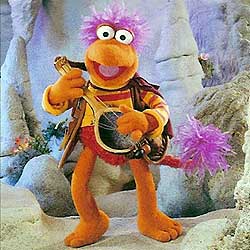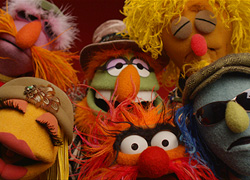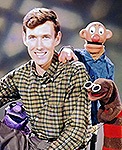Teenager's,
A portfolio is a showcase of your very best work. Refering to portfolios I was threatened with the phrase "You are only as good as your worst sketch" all through school. It is true, and it is not. They will be looking at your over all body of work and if you have one crap sketch in there out of the bunch, it won't be your demise, but if you feel that it might, leave it out. Anyway... on to your direct questions.
The number of pages varies on how much material you have on each individual project. If you have just the finished puppet then 1 page, if you have the finished puppet and sketches then 2 pages, if you have all that and your puppet has an interesting construction and you documented that or it has a unique mechanism then 3 pages. Yes, combine pictures on a page. Make them balanced and vary the sizes so that your best are biggest and your least favorite but necessary are smallest, and arrange them dynamicly. If you have some killer preformance photos then add them to the final puppet page for some added dynamic.
Put a simple but creative graphic format on your pages that is consistant trough out your portfolio. Don't let the graphic steal the show because it is just a unifyer to make you look profesional. It can change for each project, but should have a unifying location of the graphic, maybe colors, and maybe basic shapes.
As for Text, each page of each project should say something simple like "Green Monster - Muppet style" or "Stickie Finger - Rod Puppet" in the layout graphic. Don't put your name on each page because it gets annoying for the reviewer. If you feel that you need to explain something like a special mechanism, construction process, or material for a project, write a short and to the point blurb about it and add it to the page in the project that shows what your are highlighting. A short blurb about the puppet, character, and performance details can be added on the final puppet page if you feel it is totally necessary. I like to have my pages explain themselves. When I say "a blurb" I mean a short paragraph and not bullet points of information. Inject a little personality into these blurbs (I know it sounds like an oximoron).
Your resume should be boring and plain (meaning no crazy graphics for the administration office workers to look at) and should be separate from the portfolio. Send it along as a seperate document if you are emailing or hard copy mailing the portfolio along.
I learn by example, so here is an example. This is a little section of my portfolio from my last student project I did a couple years ago. It's an Industrial Design project.
http://www.coroflot.com/public/indi...ue&sort_by=1&set_id=90686&individual_id=99651
Holy cow! This is a lot longer of a response than I anticipated, but I hope this crash course helps you. These are not rules, just guidelines and use your artistic eye to get things the way you think they should be even if you go against everything I said.
-Julie



 Welcome to the Muppet Central Forum!
Welcome to the Muppet Central Forum! Back to the Rock Season 2
Back to the Rock Season 2 Sesame Street Season 54
Sesame Street Season 54 The Muppets Mayhem premieres
The Muppets Mayhem premieres Bear arrives on Disney+
Bear arrives on Disney+ Sam and Friends Book
Sam and Friends Book